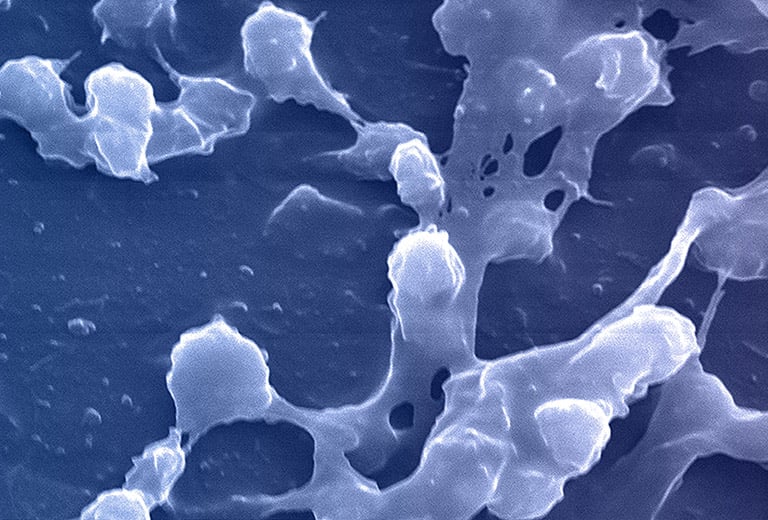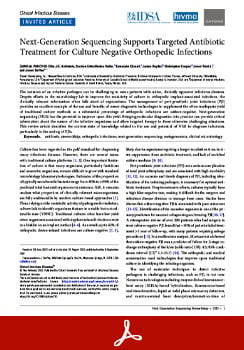Next-Gen DNA Sequencing (NGS) is the Emerging Gold Standard for ID Diagnosis and Management
Expand clinical impact through enhanced diagnostic power

Credit: CDC/ Rodney M. Donlan, Ph.D.; Janice Haney Carr
MicroGenDX qPCR+NGS greatly increases the speed and precision for identifying mycobacteria, fungi, anaerobes, and microbes embedded in biofilms — at the lowest cost and fastest turnaround time of any reference laboratory in the industry,* and is reimbursed by Medicare.
“NGS is a revolutionary, transforming technology for the diagnosis and treatment of infectious diseases.” — Joseph F. John Jr., MD, FIDSA
American Academy of Microbiology colloquium praises potential of NGS
The two-day colloquium concluded that NGS “has the potential to dramatically revolutionize the clinical microbiology laboratory,” and “may well become the cornerstone of clinical care.” The report describes how NGS can provide diagnostic results in the most relevant time frame to positively impact patient outcomes, reducing what can otherwise be a “guessing game” of diagnosing and identifying infectious diseases with a battery time-consuming tests. Read report
Orthopedic surgeons use MicroGenDX NGS to diagnose and manage PJI

A landmark 15-center study demonstrated 68.6% of revision failures following two-stage exchange were due to untreated or undertreated pathogens missed by culture, but detected by MicroGenDX NGS at the time of initial resection. Only 8.6% of failures had negative NGS results at the time of revision surgery. This study was presented at the 2020 AAHKS. Read about study
MicroGenDX research partners and published research
MicroGenDX partners with researchers across multiple disciplines who are engaged in both single-site and multi-site studies examining the clinical advantages of NGS. View a list of some of our current research partners
MicroGenDX also has more published studies (70+) than any other molecular lab that support the evidence-based clinical utility of our qPCR+NGS capabilities.
The industry leader in speed and affordability
- qPCR results within 24-48 hours for antibiotic resistance genes and targeted panel identification of AFB, bacteria, and fungi
- NGS results within 3.5 days for comprehensive AFB, bacteria, and fungi identification
- Outpatient testing cost reimbursed by Medicare, select Medicaid, and commercial plans
- $100 for direct colony identification
- Competitively priced inpatient specimen identification (please contact MicroGenDX or your representative for pricing)
- Discount for outpatient testing self-pay
15+ years of 16S/ITS NGS testing quality and reliability
With over 750,000 qPCR+NGS samples processed, referencing against a validated microbial database of 57,000+ microbes, MicroGenDX ensures representation of every possible infective organism. This comprehensive accuracy has been consistently confirmed by a 99.2% CAP proficiency average from more than 1,000 blinded specimens. MicroGenDX has also been a trusted research partnership lab for the FDA, NASA, and the CDC. View CAP data
Advantages of qPCR+NGS over culture
| Traditional Culture | MicroGenDX qPCR+NGS |
|---|---|
|
|
|
|
|
|
Molecular testing recommended by IDSA for acute respiratory tract infections
A 2020 IDSA study concluded that rapid molecular testing has several potential benefits, including:
- Reducing unnecessary antibiotic use
- Shortening hospital or emergency department stays
- Limiting additional ancillary testing
- Optimizing infection control practices
- Improving antiviral prescribing
The study also concluded that simultaneous molecular testing for multiple respiratory viruses may also be more cost-effective than traditional antigen- or culture-based methods — especially when considering the thresholds of disease prevalence. Read IDSA recommendations
References
- Weinstock M, Godberg B, Ledeboer N, et al. Applications of Clinical Microbial Next-Generation Sequencing: Report on an American Academy of Microbiology Colloquium held in Washington, DC, in April 2015. American Society for Microbiology. 2016. 10.1128/AAMCol.Apr.2015


 Direct Colony Identification
Direct Colony Identification Identification from Specimens
Identification from Specimens